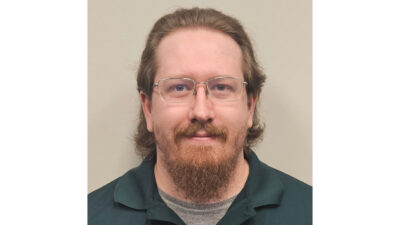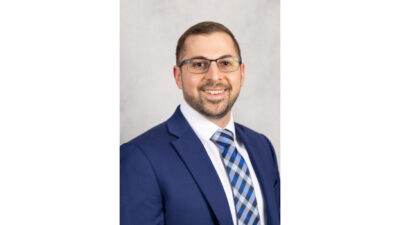When AK Steel built a new greenfield plant at Rockport, IN, it was faced with a daunting challenge: Establish and continue the highest possible levels of plant maintenance from day one. The solution was innovative: Build a top-flight maintenance organization quickly by contracting for maintenance services, and base the contract on performance.
Above: A large view of the continuous galvanizing steel line at AK Steel Rockport Works, Rockport, IN. Coil steel is fed from the
|
When AK Steel built a new greenfield plant at Rockport, IN, it was faced with a daunting challenge: Establish and continue the highest possible levels of plant maintenance from day one. The solution was innovative: Build a top-flight maintenance organization quickly by contracting for maintenance services, and base the contract on performance.
The challenge was met by creating an alliance known as Rockport Maintenance (RM), which combines the resources of Fluor and Siemens Energy & Automation. RM is headed by Maintenance Site Manager Ed Miltenberger who reports to the AK Steel Rockport Works Maintenance Manager Dennis Brickley.
How is the arrangement working? Just four years after startup, Rockport Works has been honored with the North American Maintenance Excellence Award, sometimes called the “Baldrige Award for maintenance.” The plant has also earned QS9000 certification and Q1 status from Ford Motor Co.
In the beginning
The decision to use contract maintenance came long before construction of the Rockport Works.
AK Steel’s Chairman, CEO, and President Richard M. Wardrop, Jr., says that the concept was talked about in the early stages of designing the plant. “When we settled on Siemens to do all the electrical for the cold mill and the galvanizing line, it became apparent that it would make a lot of sense to have the people who designed the system maintain the system,” Wardrop explains. “We were hoping to get a technological advantage in that the people who built the machinery knew how to maintain it.”
Second, Wardrop says, was the synergy that could be developed by combining the capabilities of Siemens and Fluor — Siemens for its technological expertise on the systems and equipment, and Fluor for its predictive maintenance and maintenance management experience.
And finally, Wardrop continues, “We figured we could do it with the least people if we had the best people.”
Control room overlooks the five-stand continuous cold mill, which is capable of rolling both carbon and stainless steels. At 60,000 hp, it is the most powerful continuous tandem cold mill in the world.
Performance is key
An unusual feature of the Rockport Maintenance contract is that payments are based on performance. If RM doesn’t perform to specific, measurable levels, payments are adjusted. RM performance is measured on safety, quality, productivity, and cost each month.
RM puts 10% of its contract rate “at risk.” That is, if RM doesn’t perform to agreed-on performance levels, it could lose up to 10%. But in the other direction, it can earn a “bonus” of up to 30% for exceptional performance.
Performance goals are set by AK Steel and agreed to by RM. Some goals change monthly as the plant’s business plan changes.
Miltenberger sees the at-risk kind of contract as a positive. “I think you get good participation from the maintenance provider with an at-risk contract,” he says. “It empowers me to say what I think, instead of what the customer wants to hear, because I have a stake in it. In the total picture, I believe that all three of the companies participating in this [AK Steel, Fluor, and Siemens] are reaping benefits from it.”
Striving for excellence
Having an organization and performance-based incentives in place is not enough to ensure operational excellence, however. And in a new plant the size and complexity of Rockport Works, the learning curve is steep.
Brickley credits two priorities as major factors in attaining the maintenance levels they did as quickly as they did.
The first was never giving up on predictive maintenance. Brickley held fast to the collection of baseline data as equipment and systems were started up, even while other areas were still under construction. There was tremendous pressure to pull people off of predictive maintenance to work on other projects, he recalls. But working on predictive maintenance from the beginning is now paying off, he says.
“Planned work costs half as much as unplanned work,” he asserts, “and predictive maintenance lets us plan our work.”
The second priority was to never make the same mistake twice. By that, Brickley means that problems and their causes have to be documented and communicated so that they can be eliminated. To Brickley’s way of thinking, reworks, repeated problems or breakdowns, and failure to identify root causes all fall under the “same mistake twice” umbrella.
Going for the gold
As a veteran of involvement in earning the NAME Award at two other plants (one, a US Steel plant, the other an AK Steel facility), Brickley is a big supporter of the progress that can be made when the goal is clear.
“When the guys in Rockport Maintenance told me they wanted to apply for the NAME Award, I didn’t think we had a chance,” Brickley says. “I didn’t think the maintenance process in a new, greenfield plant like ours would be that far along this quickly.”
“It’s been a tough battle,” Brickley says of the past 5 yr or so. “A lot of long hours and hard work. Not at fighting fires, but hard work at doing the right things for the right reasons. I’m really proud of these guys.”
Never-ending story
Despite the levels of excellence already attained, the challenges never end. As a contractor, for example, Rockport Maintenance is intent on building a completely seamless integration with operations. This can be difficult in any plant, but the integration of a contractor with plant management can be especially difficult.
One key to success are the alignment of goals and effective communications. And both AK Steel and RM are working to accomplish these. Daily morning meetings between operations managers and maintenance leads as well as daily meetings between plant general management and the RM leadership team help build relationships.
For a plant just four years old, Rockport Works demonstrates that the foundations of long-term success have been laid. But there remains a keen awareness that strengthening and building on those foundations is an effort that never ends.
Eric Petersen, Rockport Works general manager, puts this fact into perspective: “Steel is a low-margin commodity, which requires us to do it right the first time. The road to success is not operations, it’s maintenance. We have to have our equipment perform at top levels through outstanding maintenance practices all the time. It’s more important for us to be an outstanding maintenance group than to be outstanding operators. We’re more likely to succeed if we’re an outstanding maintenance organization.
AK Steel Rockport Works — by the numbers
| Activities: | Continuous pickle line |
| Anneal and pickle line | |
| Continuous cold mill | |
| Temper mill | |
| 30-base hydrogen annealling unit | |
| Continuous galvanize/galvanneal line | |
| Support processes for high-end, value-added, 300 series and 400 series stainless and carbon sheet and strip used in automotive and appliance manufacturing | |
| Site: | 320 acres of plant on a 1730-acre site |
| 1.75 million sq ft under roof | |
| Total estimated replacement value, $1.17 billion | |
| Workforce: | More than 600, including permanent onsite contractors |
| Safety: | Lost-time injuries per 100 workers: |
| 0.00 for 2001 | |
| 0.12 for 1999-2000 | |
| Technical training: | 40 hr/maintenance person annually |
| Uptime: | 90% overall |
| 96.5% maintenance related | |
| Maintenance workforce: | 46 maintenance support staff |
| 145 direct maintenance | |
| Maintenance scheduling: | Routine repair, 100% |
| Shutdown/turnaround, 92% | |
| Planned repair schedule compliance, 85% |
The NAME Award
Mission: The North American Maintenance Excellence (NAME) Award is an annual program conducted by the Foundation for Industrial Maintenance Excellence to recognize North American companies that excel in performing the maintenance process to enable operational excellence.
Objectives: The NAME Awards program seeks to
Increase the awareness of maintenance as a competitive edge in cost, quality, safety, service, and equipment performance
Identify industry leaders and highlight best practices in maintenance management
Share successful maintenance strategies and the benefits derived from their implementation
Understand the need for managing change and stages of development to achieve maintenance excellence
For more information , visit the NAME web site at nameaward.com.



